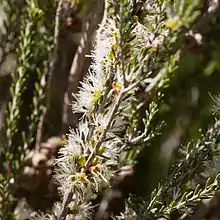| Mallee honey-myrtle | |
|---|---|
 | |
| Melaleuca brevifolia near the Coorong | |
| Scientific classification | |
| Kingdom: | Plantae |
| Clade: | Tracheophytes |
| Clade: | Angiosperms |
| Clade: | Eudicots |
| Clade: | Rosids |
| Order: | Myrtales |
| Family: | Myrtaceae |
| Genus: | Melaleuca |
| Species: | M. brevifolia |
| Binomial name | |
| Melaleuca brevifolia | |
| Synonyms[1] | |
Melaleuca brevifolia, commonly known as mallee honey-myrtle, short-leaf honey-myrtle, or d'Alton's melaleuca is a shrub or tree in the myrtle family, Myrtaceae, and is native to western Victoria, south-eastern South Australia and the south-west of Western Australia. It is a shrub with rough, corky bark and a large number of heads of white to yellowish flowers on the previous season's growth. It is a moderately hardy garden plant.
Description
Melaleuca brevifolia is a shrub, rarely a tree, growing to a height of 4 m (10 ft) with rough, corky bark. Its branches and leaves are glabrous except when young. Its leaves are arranged in pairs, sometimes in threes and are 2.4–8 mm (0.09–0.3 in) long, 0.7–1.5 mm (0.03–0.06 in) wide, linear to lance-shaped with the thinner end at the base and have blunt tips. On their lower surface there are two rows of raised oil glands.[2]
The flowers are white to yellowish and are arranged in heads on the previous season's growth. Each head is up to 18 mm (0.7 in) in diameter and contains up to six individual flowers. The stamens are arranged in five bundles around the flowers with 10 to 12 stamens in each bundle. The main flowering season is in spring and the fruits that follow are wrinkled, cup-shaped capsules 3.3–4.2 mm (0.1–0.2 in) long and wide.[2][3][4]
Taxonomy
Melaleuca brevifolia was first formally described in 1852 by Nikolai Turczaninow in Repertorium Botanices Systematicae.[5][6] The specific epithet (brevifolia) is derived from the Latin words brevis meaning "short" and folium meaning "leaf", referring to the small leaves.[2]
Distribution and habitat
This melaleuca occurs in the Mallee, Loddon and Wimmera regions of Victoria,[4] the south-east of South Australia[7][8] and the south-west of Western Australia in the Avon Wheatbelt, Esperance Plains, Geraldton Sandplains, Mallee and Swan Coastal Plain biogeographic regions.[9] The species is found in swampy areas, near salt lakes[9] in heathlands and shrublands.[4]
Conservation status
This species is listed as "not threatened" by the Government of Western Australia Department of Parks and Wildlife.[9]
Use in horticulture
Melaleuca brevifolia is a moderately hardy garden plant requiring good drainage and a sunny position.[10] It is useful for harsh conditions, including salty soils or those containing limestone.[3]
References
- 1 2 "Melaleuca brevifolia". Plants of the World Online. Retrieved 25 August 2021.
- 1 2 3 Brophy, Joseph J.; Craven, Lyndley A.; Doran, John C. (2013). Melaleucas : their botany, essential oils and uses. Canberra: Australian Centre for International Agricultural Research. p. 97. ISBN 9781922137517.
- 1 2 Holliday, Ivan (2004). Melaleucas: a field and garden guide (2nd ed.). Frenchs Forest, N.S.W.: Reed New Holland Publishers. pp. 34–35. ISBN 1876334983.
- 1 2 3 "Mallee Honey-myrtle". State Government of Victoria, Department of Environment and Primary Industries. Retrieved 1 May 2015.
- ↑ "Melaleuca brevifolia". APNI. Retrieved 1 March 2015.
- ↑ Turczaninow, Nikolai (1852). "Myrtaceae Xerocarpicae in Nova Hollandia". Bulletin de la classe physico-mathématique de l'Académie Impériale des sciences de Saint-Petersburg. 10: 342. Retrieved 1 May 2015.
- ↑ Foulkes, J.N.; Heard, L.M.B. "South East Biological Survey: Conclusions and conservation recommendations" (PDF). Government of South Australia:Department of Environment, Water and Natural Resources. Retrieved 1 May 2015.
- ↑ Horn, Troy. "Draft revised management plant:Deadmans Swamp Native Forest Reerve" (PDF). Government of South Australia:Forestry. Retrieved 1 May 2015.
- 1 2 3 "Melaleuca brevifolia". FloraBase. Western Australian Government Department of Biodiversity, Conservation and Attractions.
- ↑ Wrigley, John W.; Fagg, Murray (1983). Australian native plants : a manual for their propagation, cultivation and use in landscaping (2nd ed.). Sydney: Collins. p. 261. ISBN 0002165759.